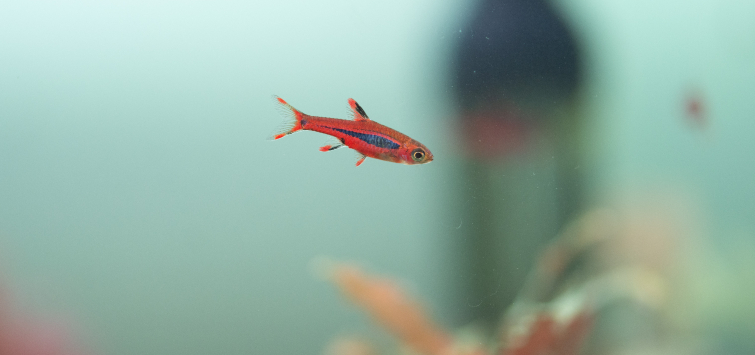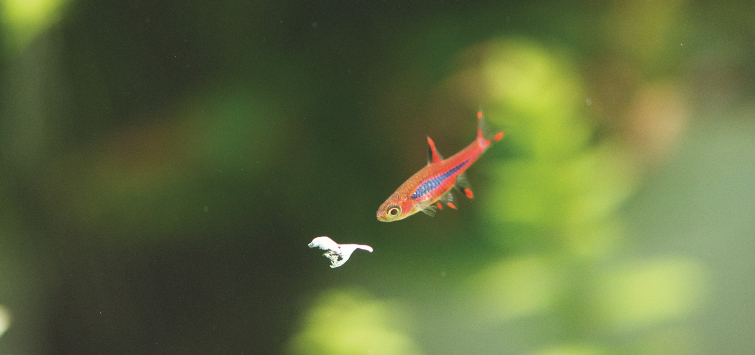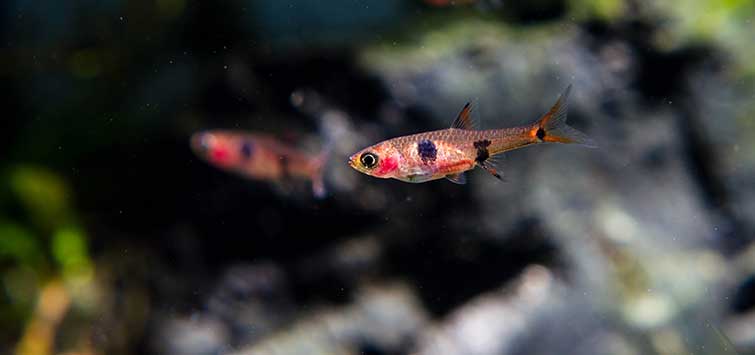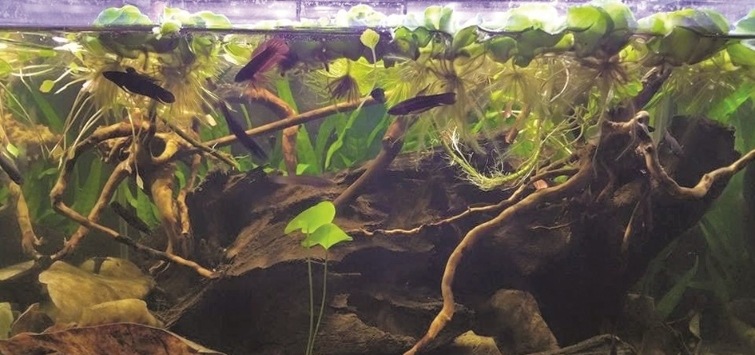Chili Rasbora Care: Keeping Tiny Jewels
Andrej Jakubík
The true measure of a fish should never be judged merely by its size, as even the smallest species can possess remarkable qualities. Aquarists often hold a special appreciation for endemic fishes, those species found only in specific locations, carrying an aura of uniqueness often missing in more widespread counterparts. The diminutive Boraras brigittae, known in the aquarium hobby as the chili rasbora, is a perfect example.
Our story begins in 1978, in the dark, humid rainforests near Banjarmasin on the island of Borneo. Imagine a tiny stream, barely visible through dense vegetation, flowing as a tributary of the larger Barito River. Its water is a stunning, clear black, stained by tannins leaching from fallen leaves, branches, and peat that make up the stream bed.
These waters are shallow, soft, and acidic, sometimes with a pH as low as 4.0, reflecting the mineral-poor peat swamp environment. Sunlight struggles to penetrate the canopy, making aquatic plants scarce, though hardy mosses might cling to life in the dim light.
It was in such waters that Dieter Vogt first encountered some tiny, brightly colored fish. Their slender bodies, often less than an inch long, glowed in shades of red and orange, marked by a delicate dark line from head to tail. Swimming in small groups, perhaps for protection or communication, their vivid coloration stood out against the dark backdrop.
Recognizing their significance, Vogt scientifically named the fish Rasbora urophthalma brigittae in honor of his wife, Brigitte. Later reclassified as Boraras brigittae, it’s now commonly known as the chili rasbora or mosquito rasbora. The genus name Boraras itself is an anagram of Rasbora, cleverly signifying the diminutive size of these species compared to their larger relatives.

Setting Up an Aquarium
The chili rasbora is a delightful freshwater fish belonging to the Cyprinidae family, native to the peat swamp forests of southwest Borneo and Indonesia. Typically reaching only 0.4 to 0.8 inches (1 to 2 cm), males are usually smaller and boast more vibrant colors than the fuller-bodied, paler females.
Successful chili rasbora care hinges on replicating their natural blackwater environment. This means providing soft, acidic water, ideally with dense vegetation. Aim for a temperature between 77° and 82°F (25° to 28°C), a pH from 4.0 to 7.0, and water hardness between 1 and 5 dGH.
Adhering to these parameters is not just preferential, but crucial for their health. As softwater fish adapted to low osmotic pressure, chili rasboras experience significant physiological stress in hard water. They struggle to excrete excess salts, leading to mineral buildup and cellular dehydration. Their kidneys, not designed for high mineral loads, become overworked, potentially leading to kidney failure.
Furthermore, hard water can alter their protective mucus layer, increasing vulnerability to infections and parasites, and may even cause tissue calcification. Providing the correct water chemistry is paramount for a long and healthy life; while they typically live 2 to 4 years, utilizing chili rasbora care with optimal conditions can extend their lifespan. Creating an appropriate biotope for B. brigittae involves several considerations. A dark substrate is recommended, as chili rasboras can appear pale or washed-out over light-colored bottoms. Adding dried botanicals like Indian almond, banana, or papaya leaves helps release beneficial tannins and slightly lower the pH, mimicking their natural habitat.
Lighting should be subdued and diffused, with plenty of shaded areas. While they might survive in bright tanks, intense light can cause chronic stress, even if not immediately apparent. Use floating plants or dense planting near the surface to create comfortable, dimmer zones where the fish feel secure. Remember, the aquarium is primarily for the fish, and their environmental needs should come first.
Enjoying TFH Magazine? Subscribe Today!
Selecting Plants and Tankmates
When selecting plants, focus on species tolerant of soft, acidic water and lower light levels. Various Cryptocoryne species like Cryptocoryne ciliata, C. pontederiifolia, and C. cordata are excellent choices. Blyxa japonica forms dense clumps offering shelter, while Limnophila and Eleocharis species can also thrive. Floating plants are highly beneficial. Provided the water surface is relatively calm, they help absorb excess nutrients, thus limiting algae growth, and effectively dim the overhead lighting, contributing significantly to a natural feel.
Being peaceful and tiny, chili rasboras require equally gentle tankmates. Ideal companions include other small, placid species that won’t intimidate or outcompete them. Other Boraras species, like the phoenix rasbora (B. merah) or dwarf rasbora (B. maculatus), are excellent choices, often schooling together. The blue neon rasbora (Sundadanio cf. axelrodi) and, with sufficient hiding places, the sparkling gourami (Trichopsis pumila) can also be suitable.
Small bottom-dwellers like pygmy cories (Gastrodermus pygmaeus) or dwarf cories (Hoplisoma habrosum) generally coexist peacefully. Peaceful invertebrates like shrimp and common aquarium snails are usually safe additions. Conversely, avoid predatory shrimp like Macrobrachium species, which can harm small fish. Always research potential tankmates thoroughly to ensure compatible needs.
Feeding and Nutrition
Feeding chili rasboras requires attention to their small mouths and diet. In the wild, they consume tiny insects, larvae, worms, and zooplankton. In the aquarium, they readily accept high-quality micro-flake or granulated foods formulated for small fish.
However, adding live or frozen foods is the best choice for optimal health and color. Frozen Cyclops is particularly ideal due to its small size, excellent nutritional profile (proteins, fats like omega-3s), and natural carotenoids that enhance the fish’s vibrant red coloration. The chitin found in Cyclops and other frozen foods like daphnia also provides beneficial fiber.
Offering live foods like Cyclops also stimulates natural hunting instincts. Aim for a diet containing roughly 50 percent protein and 10 to 15 percent fat, ensuring it includes essential vitamins and trace elements. Never underestimate the importance of quality food for fish health.

Breeding & Fry Care
Chili rasbora breeding is possible in captivity but it is often considered challenging, primarily because success relies heavily on achieving the correct soft, acidic water parameters. When ready to breed, males display intensified colors, signaling their health and vitality to potential mates.
This vibrant coloration is linked to fat reserves; a loss of color can indicate health or nutritional issues. Reaching sexual maturity around four months, males may engage in harmless displays to establish dominance and mating priority.
Spawning typically occurs in the early morning. As egg scatterers, they release eggs randomly among fine-leaved plants like Java moss, providing no parental care afterwards. A female might release only a few or dozens of sticky eggs daily over several days.
For chili rasbora breeding, a dedicated tank with a bare bottom, some Java moss, and a gentle sponge filter works well for a small group (6 to 10 fish, with more males than females). Feeding live foods during this time can help distract the parents from consuming the eggs.
The eggs typically hatch within 24 to 48 hours at around 82°F (28°C). The fry absorb their yolk sacs over the next 4 or 5 days. Once they become free-swimming, they are incredibly tiny and require microscopic food like infusoria (paramecium) immediately to survive.
Interestingly, some aquarists observe “spontaneous breeding,” where fry appear in well-established, densely planted community tanks without deliberate intervention. This usually occurs when conditions are ideal and sufficient hiding places exist among plants.
The importance of correct water parameters for chili rasbora breeding cannot be overstated. Even if spawning occurs in unsuitable hard water, success is unlikely. Sperm motility is reduced in hard water, lowering fertilization rates, and unfertilized eggs quickly succumb to fungus. If fertilization does occur, embryos struggle to develop correctly in hard water due to osmotic stress and mineral interference, often leading to developmental defects, stunted growth, or death.
While chili rasboras aren’t known for specific diseases, they are highly sensitive to stress from factors like poor water quality or transportation, which can sometimes lead to sudden death without obvious symptoms.
The Future in the Wild
Sadly, the future for wild B. brigittae populations is uncertain. Their numbers are declining primarily due to habitat loss and degradation across Borneo, largely driven by deforestation and the draining of vital peat bogs.
The expansion of palm oil cultivation poses a significant threat, similar to the challenges faced by wild Betta populations. Palm oil production generates vast amounts of toxic wastewater, which pollutes waterways, depletes oxygen, and contains heavy metals harmful to aquatic life. This pollution disrupts reproduction, lowers survival rates, causes abnormalities in young fish, and impairs essential behaviors like feeding and predator avoidance. One simple way consumers can help protect the habitat of chili rasboras and other affected species is by consciously choosing products that do not contain palm oil.
A Jewel Worth Protecting
In the delicate dance of nature, the chili rasbora shines as a testament to the beauty and resilience of even the smallest creatures. By crafting aquariums that mirror their wild blackwater homes, we not only bring their vivid colors to life but also honor their fragile existence. As we care for these tiny jewels, let us also commit to protecting their natural habitats, ensuring that future generations can marvel at the brilliance of B. brigittae, in our home tanks as well as in the wild streams of Borneo.

.png?h=595&iar=0&w=2781&hash=5FD5E69473BCC22199FBFA2FB71B6033)



